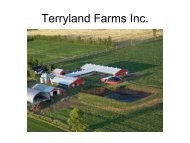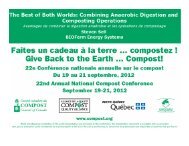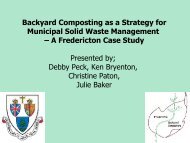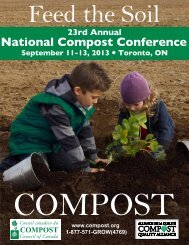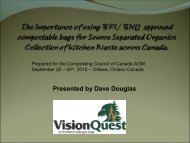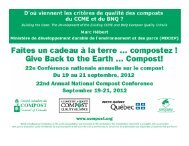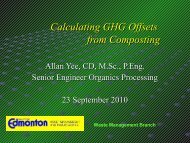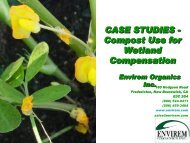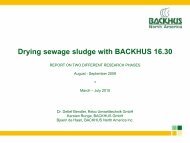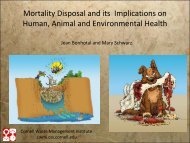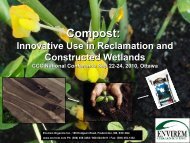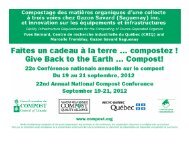John Paul, Transform Compost Systems
John Paul, Transform Compost Systems
John Paul, Transform Compost Systems
Create successful ePaper yourself
Turn your PDF publications into a flip-book with our unique Google optimized e-Paper software.
<strong>Compost</strong>ing 1000 tonnes per day<br />
A Continuous Aerated Windrow System<br />
TRANSFORM<br />
<strong>Compost</strong> <strong>Systems</strong><br />
<strong>John</strong> <strong>Paul</strong>, Ph.D.<br />
CCC Conference 2010
How Do We Deal with Organic Waste Diversion From<br />
Very Large Cities<br />
- some cities have 5000 tonnes + per day of organic waste!
How much organic waste is 1000 tonnes per day<br />
2540 tonne trailers per day!<br />
Even energy recovery processes still need to handle a<br />
lot of bulk material before and after energy recovery!
How much organic waste is 1000 tonnes per day<br />
325 6 yard buckets per day!
We first have to accept some basic<br />
principles of composting
Principles of <strong>Compost</strong>ing<br />
1.<strong>Compost</strong>ing is an aerobic process and hence needs<br />
aeration and/or turning<br />
2.<strong>Compost</strong>ing has the potential to pollute, therefore<br />
must be protected from precipitation in wet climates<br />
3.<strong>Compost</strong>ing is a biological process and requires time<br />
4.<strong>Compost</strong>ing generates heat which kills pathogens,<br />
increases microbial activity to stabilize carbon, and<br />
evaporates moisture<br />
5.Odor potential increases with increased moisture<br />
content, decreased oxygen supply, and increasing<br />
amounts of food waste
this violates most of the principles of composting<br />
One can say its a slightly more organized version of……
…this!
this can hardly be called composting: it is difficult<br />
to maintain control of the process in either dry or<br />
wet season<br />
CCC Conference 2010
Outdoor Turned Windrows<br />
Inexpensive to begin, but will be quite difficult to maintain<br />
control of the process in either dry or wet season<br />
With 10 m wide x 3 m high windrows – need 500 m 2 per day<br />
With 5 m wide x 2 m high windrows – 1200 m 2 day
Outdoor Turned Windrows<br />
Inexpensive to begin, but will be quite difficult to maintain<br />
control of the process in either dry or wet season
We now have the option of working under a roof, but<br />
space requirements are significant<br />
With 10 m wide x 3 m high windrows – need 500 m 2 per day<br />
With 5 m wide x 2 m high windrows – 1200 m 2 day
Additional challenges with<br />
turned windrow systems<br />
inside a building - not so<br />
easy for a turner operator<br />
to see
Blower off<br />
Blower<br />
on<br />
We now want to optimize our indoor space – we need to turn<br />
more often, or provide forced aeration to speed up the process
We should now consider other<br />
technology choices as well<br />
-Aerated bunker<br />
-Covered aerated windrow<br />
-Continuous aerated bed<br />
-Agitated bed
We should also consider some rules of thumb for<br />
composting<br />
1.<strong>Compost</strong>ing is optimized at moisture contents of 50-65%,<br />
and bulk densities of 600 to 700 kg per cubic meter<br />
2.<strong>Compost</strong>ing will result in a 30-50% volume loss depending<br />
on process conditions<br />
3.Static aerated systems require greater porosity to prevent<br />
preferential air pathways<br />
4.The amount of drying depends mostly on the<br />
temperature above the composting material<br />
5.<strong>Compost</strong>ing is very corrosive, use appropriate building<br />
material
Rules of thumb for composting<br />
<strong>Compost</strong>ing is optimized at moisture<br />
contents of 50-65%<br />
<strong>Compost</strong>ing at 65% moisture – 1000 tonnes per day = 325 buckets<br />
If we have to decrease to 55%, we have to add 700 tonnes of a 40%<br />
moisture content bulking agent = total of 566 buckets/ day
Technology choices impact capital and operating cost<br />
65% moisture to 55% moisture – from 325 buckets to 566 buckets/day<br />
We double the size of the facility required<br />
If we have to handle 3 x with loader, we now have ~1500 buckets/day<br />
At a cost of $120/hour, and 1 minute/bucket = $ 3400 per day
Rules of thumb for composting<br />
<strong>Compost</strong>ing will result in 30-50%<br />
volume loss depending on conditions
Rules of thumb for composting<br />
Static aerated systems require greater<br />
porosity to prevent preferential air<br />
pathways
Rules of thumb for composting<br />
The amount of moisture removed<br />
increases with increasing air<br />
temperature above the composting<br />
mass.<br />
Summer in New York<br />
35% moisture after 10 days<br />
65% moisture coming into<br />
channels
Rules of thumb for composting<br />
<strong>Compost</strong>ing is very corrosive, so we<br />
should use appropriate building material
We also have to think about operations cost, and<br />
the type of material that we are processing, and<br />
for worker health and safety, and…..
Can we start with a cost effective, corrosion<br />
resistant building structure
Can we optimize the use of this space with a large<br />
aerated windrow, say 10 m wide by 3 m high<br />
We can aerate this pile with an aeration system in the floor<br />
How are we going to turn or mix this material
We then need a machine<br />
that is remotely<br />
controlled, and moves<br />
the entire windrow 10-12<br />
m through the building,<br />
and can adjust for<br />
volume reduction during<br />
composting
We have a cost effective composting process that optimizes<br />
the use of space, and optimizes the process using aeration<br />
and turning – process time up to 8 weeks.
Higher moisture content material<br />
Catch the leachate at the beginning, and put it back in after 3-4 weeks.<br />
Still have time for pathogen kill in the 8 week process
Summary<br />
We have to start thinking creatively if we are going to benefit from<br />
our organic waste, whether through “energy recovery” production, or<br />
composting.<br />
We have to remember that even “energy recovery” will leave a lot of<br />
organic material behind that we still need to do something with!



